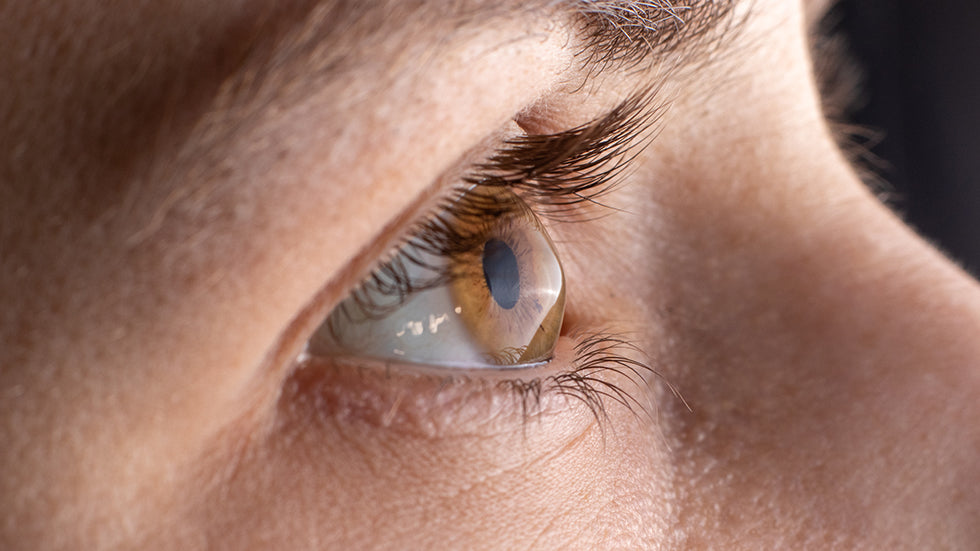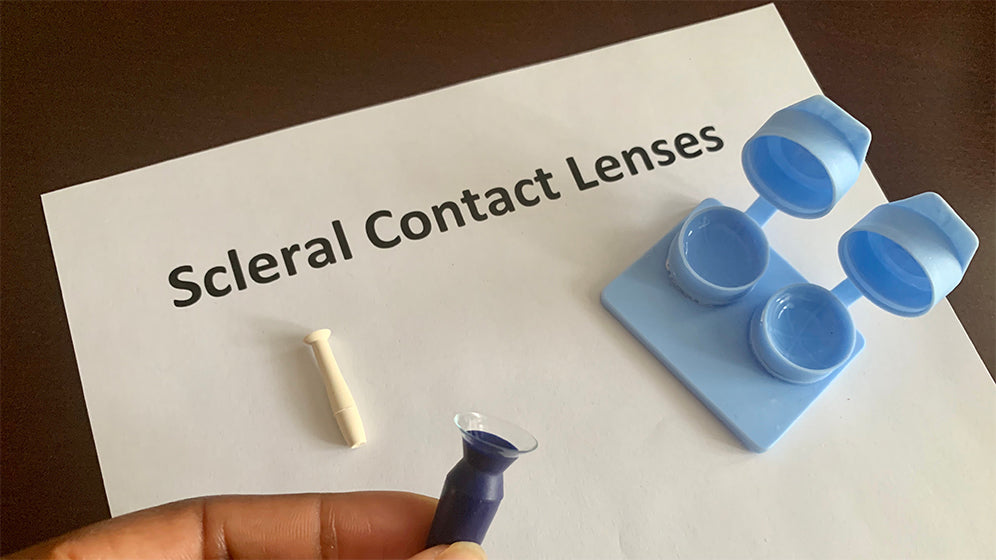Keratoconus (ker-uh-toe-koh-nus), often abbreviated KC, is a condition that affects the cornea, the clear surface on the front of the eye that focuses light. The cornea gradually thins over time and eventually bulges into a cone shape. Since the cornea should be round, the cone-like shape causes visual changes and challenges such as blurry vision, glare, and sensitivity to light. To understand how keratoconus can impact your vision, let’s take a quick look at how vision works.

Light coming into the eye goes on a journey to make it to the brain and form the images we know as vision. Light entering the eye is focused by the cornea, it must then pass through the pupil, the inner ocular lens, and finally the retina which sends a signal to the brain. The cornea and lens work together to focus the light onto the retina. Since the cornea is the point of entry for light, a misshapen cornea will not be able to focus the light on the right path to make it all the way through the process. This can make even normal daily tasks incredibly challenging! Keratoconus itself is not considered a disability, however, severe vision impairment does qualify as a disability.
Symptoms and Causes of Keratoconus
Although studied for many years, there are still unknowns about the cause of keratoconus. Doctors have determined that some genetic factors exist (10% of people with KC have a parent with it, too). Research has identified risk factors such as eye allergies and excessive eye rubbing. Certain connective tissue disorders also impact the corneal tissue and can lead to a diagnosis of keratoconus. Many are diagnosed in their teen years but others do not show symptoms until they are adults. Keratoconus can affect one or both eyes and more than half of patients are male.
Many people have the very frustrating experience of not being able to see as well as they used to with their glasses or contact lenses leading up to their diagnosis. This usually prompts their eye care practitioner to perform more testing or refer them to a specialist. Other symptoms one might experience include
- blurry vision
- glare around lights
- reduced night vision
- sensitivity to light
- eye irritation (feeling of something in your eye)
- headaches
Diagnosis and Treatments for Keratoconus
To diagnose keratoconus, the curvature, thickness, and overall shape of the cornea must be measured. Your doctor, or their staff, will perform these tests and take other various measurements. Pachymetry, measuring corneal thickness, and Keratometry, measuring corneal shape are very standard tests that will be performed. Both are fast and non-invasive. A computerized map of the cornea will be taken by either topography or tomography. These tests have come a long way and can detect even early signs of keratoconus. Your vision will be checked and your doctor will assess the overall health of the inside and outside structures of your eyes. Finally, if being fit with contacts to treat your keratoconus, your doctor will place trial lenses on your eye to finalize the absolute best fit and vision.
Lost vision from keratoconus cannot be restored, but the disease of keratoconus can be very well managed. Treatments for KC have also improved a great deal in the last few years. Not that long ago, the primary treatment was corneal RGP lenses, (the small ones), or special soft lenses. In recent years, scleral lenses have made a giant comeback and impact in the world of keratoconus.
One of the most used treatments is scleral lenses. Scleral lenses help to manage the symptoms of keratoconus by creating a new, round surface to focus the light through the rest of the eye. Scleral lenses do not land or rest on the cornea. They land just outside the cornea on the sclera, the white part of the eye. This actually improves comfort and allows your doctor to include very detailed and complicated measurements needed to create custom lenses just for you. To learn more about scleral lenses, visit
https://tangiblescience.com/blogs/care-tips/guide-to-scleral-contact-lenses
Corneal rigid gas permeable lenses or RGPs, soft lenses, and hybrid lenses are also used to treat keratoconus, depending on the severity or progression of the disease.
In recent years, developments in contact lens technology have provided ways to improve the wettability of RGP contact lenses. Better wetting lenses improve comfort, vision, and the overall quality of the wearing experience. Plasma has become a very common added treatment that leaves the lenses free of any trace amounts of debris. The effects can last several weeks. Tangible Hydra-PEG coating is also emerging as a standard of care for custom lenses. The coating is applied after plasma treatment and further improves wettability and renders the lenses more deposit resistant with longer-lasting wettability.
Corneal Crosslinking can slow down the progression of keratoconus. This newer treatment is done by using Vitamin B12 (Riboflavin) and UV light to strengthen the collagen fiber of the cornea. Corneal Crosslinking can prevent further loss of vision, but, many people must still manage their vision with custom contact lenses after having Corneal Crosslinking.
Corneal transplants are still being performed for the most severe cases of keratoconus. The irregular cornea is replaced with donor tissue in a surgical procedure. Most patients will still need to wear custom contact lenses after the surgery to manage their vision.
Early detection of keratoconus can make all the difference in your treatment options. Talk with your medical and vision insurance providers about your diagnosis. Most medical plans provide coverage for treatment and some vision plans also assist with the cost of medically necessary contact lenses.
Living with Keratoconus
Everyone will have a different view of life with keratoconus. Most people fear the unknown so learn as much as you can about your condition and treatment options. Make sure you ask your doctor questions throughout your journey. Another great way to settle into your diagnosis is to share your experience and allow others to share with you. There are many support groups for keratoconus patients on social media as well as medical research and information organizations. There is even World Keratoconus Day every November. Connecting with a group or organization can be both educational and reassuring!



